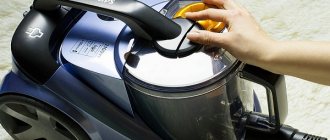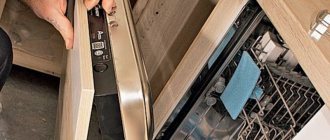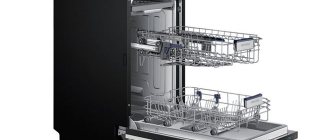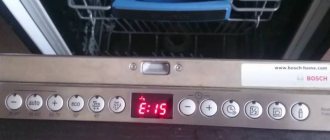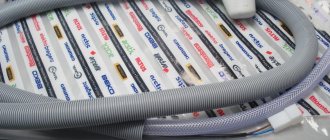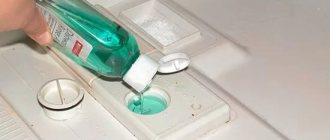With the purchase of a dishwasher, any housewife will sigh - finally, you can devote precious time to loved ones, friends and favorite hobbies. Few people think about cleaning and regular maintenance of equipment. After all, the device washes the dishes itself, which means it is clean. This is fundamentally wrong: if you do not take care of your dishwasher, the life of the appliance will be shortened and it will fail. Caring for your dishwasher will not cause much trouble, and the result will be excellent operation of the machine, without failures or surprises.
Daily preventive care
You need to keep your dishwasher clean regularly. We will describe the main procedures below.
- Once a week, wipe the door and panels of the device with a soft cloth soaked in soapy water.
- Wipe the interior surface dry after washing.
- The control panel is wiped with a semi-dry sponge, having previously wrung it out well.
- Once a month, run a washing cycle with a citric acid solution - this will prevent the formation of plaque and remove stains.
- After the wash cycle, leave the door slightly open to allow moisture to evaporate.
- Wipe the rubber seals first with a sponge and then with a dry cloth.
- Rinse the mesh filter once a week with clean water.
How to deal with rust, mold and scale
You can remove mold from your appliance using home remedies. To do this, wipe the walls with a rag soaked in hydrogen peroxide and leave them untouched for 2 hours. Then the same places are treated with “Whiteness”. At the end, a short wash cycle is started.
To clean the walls and drain system, you can buy a product from Magic Power MP-019.
You can remove plaque in the working chambers of Bosch, Siemens, Ariston, and Electrolux models with citric acid powder. To do this, pour 200 g of the substance into the detergent compartment and start the kitchen appliance. It is advisable to do this once every six months.
To avoid the formation of limescale, you must use special salt.
Dishwashing detergents
To ensure that the machine works properly, special detergents designed specifically for dishwashers are used. These include:
- Dishwasher tablets. Each capsule contains dishwashing detergent, shine and rinse aid.
- Dishwasher powder. Using the instructions for your specific model, measure the volume for one wash cycle.
- Of the useful components, manufacturers add regeneration salt in the form of large grains to soften hard water. The chemical composition is the same as that of the table mineral, but it is cleared of solid particles that do not dissolve. It is placed in a special pull-out tray or hole designed for filling with salt.
- Dishwashing gel. It comes in the form of a capsule, which is designed for one cycle of operation of the device.
- Rinse aid. It is loaded into a special compartment intended for the final stage of washing.
- Air freshener that is attached to the top basket. It removes unpleasant odors, imparting aroma to the dishes.
Who is right?
Has anyone tried to open the instructions for their dishwasher and read what is written there? If not, here is a list of recommendations from the manufacturer:
- After finishing the washing and drying program, it is advisable not to immediately take out the dishes, but to let them dry completely for another couple of hours. To avoid running out of plates or glasses, run the wash overnight, and by morning the dishes will be clean and dry.
- Clean the filters regularly and as often as possible. The main unpleasant smell comes from them, especially if the problem starts.
- If you use the machine frequently and regularly clean the filters, there is no point in drying the unit from the inside every time. With such active work, mold and other microbes will not have time to multiply.
- If the dishwasher is used quite rarely, it can and should be dried to prevent the growth of bacteria. It is enough to leave the door open at least a little, and not open it completely.
The dishwasher is designed to be used at least once a week. Otherwise, the water will stagnate and emit an unpleasant odor.
Interesting:
- Is it worth buying a dishwasher - reviews
- Is it worth buying a dishwasher?
- Reviews of built-in dishwashers
- Dishwasher rating 45 cm
- Reviews of compact dishwashers
- The dishwasher doesn't wash the dishes - we fix it ourselves
Reader comments
- Share your opinion - leave a comment
Deep cleaning
For preventative purposes, you should thoroughly clean your dishwasher every six months. You can carry out this procedure more often, especially if you use the device intensively and notice a decrease in its efficiency (the dishes are not cleaned perfectly). Such servicing of the dishwasher will return the original quality of the work performed. Below are algorithms for cleaning various parts of the device.
Filters:
- unload the machine from the cutlery nets;
- unscrew the protective covers that are secured with screws;
- take a toothbrush or a special brush for cleaning filters, gel for cleaning equipment;
- carefully clean the part;
- rinse the device with running water;
- reinsert the filter device.
Drain hole:
- We wash the holes near the drain with a sponge and soapy water;
- Use a toothpick to clean the injector holes, using a sponge to remove dirt and limescale deposits.
Holes in the blades of the washing shower:
- remove the clamp and remove the blades;
- if the holes are clogged with food debris or limestone deposits, clean them with a toothpick;
- rinse with running water;
- set back;
- if the blades rotate with difficulty, clean its axis.
Door seal:
- Wash the part with refrigerator cleaner or a proprietary cleaner;
- rinse with clean water.
Cleaning the internal and external surfaces:
- spray the walls of the case with glass cleaner, then wipe with a dry cloth;
- Wipe baskets with dishwashing detergent;
- Wipe the handle and control panel with a soft cloth;
- Clean the detergent compartments with a toothbrush and rinse with running water;
- Wash the inside of the unit and the rubber seals with soapy water.
How to wash a dishwasher?
Cleaning the device is quite easy, but it is worth remembering that any actions to clean the device should be carried out only after the unit has been completely turned off, as well as after drying it after washing cycles.
6 steps to clean the unit:
- Washing the mesh filter. Cleaning frequency: at least once every 7 days. A grease deposit quickly appears on this part of the machine, which clogs the small holes in the filter.
- Cleaning the blades. Their main “enemies” are food debris and scale. First you need to remove the blades and rinse them with water, and then the holes for their placement can be cleaned with toothpicks.
- Cleaning seals. The frequency of “general cleaning” is once every six months. The spaces between the seals can be easily cleaned with a regular toothbrush or wiped with a soft, lint-free cloth.
- Washing the bottom of the door. The water stream does not reach here, so pollution accumulates constantly. The space is cleared of debris manually: with napkins, rags and water.
- Descaling. The answer to the question “How to remove scale from a dishwasher” is simple - use specialized products (for example, Electrolux product).
- Wiping down the unit. After finishing the washing process, to prevent dirt from accumulating, you need to wipe the inside of the machine. Don't forget about this - a guarantee that a thorough washing of the car will take place quickly, because... dirt will not settle layer by layer.
You should also regularly clean the drain and water supply hose. All manipulations take a maximum of 15 minutes of time, while the life of the dishwashing device is extended for years.
Worth reading: How to clean a dishwasher: 7 steps.
Anti-scale
Limestone deposits are caused by hard water. To prevent this, replenish the salt reservoir or add water softener. If a white coating has already formed, you will need one of the components to clean it:
- lemon acid;
- bicarbonate of soda;
- baking soda;
- table vinegar.
Place the selected substance in the dishwasher. The optimal temperature is 600. Afterwards, remove dirt and stains with a damp cloth. Run another cycle with just water.
You can prepare a product based on baking soda (400 g) and hydrogen peroxide (3 tbsp). Add 20 drops of essential oil to the mixture. Mix the ingredients and form small balls. Place the mixture on the bottom shelf of the appliance, and on the top shelf - 400 ml of vinegar with the addition of a spoonful of detergent. Then turn on the washing cycle, after which remove the remaining product with a damp cloth.
You should not use the product too often - after all, it is a chemical compound.
Instructions for adding detergent, rinse aid and softener
When starting up for the first time, according to the operating instructions for the Bosch dishwasher, you are supposed to add special salt to the unit to soften the water. If this is not done, streaks and residue from mineral deposits may remain on the dishes.
You can do this in the following way:
- Open the main door.
- Find the plug in the lower right corner and unscrew it.
- Pour softener through a funnel.
- Tighten the plug and set the softness control to a value from 1 to 3, depending on the water quality in the region.
When washing, salt will be added to the tank itself and soften the water. If you set the value to 0, the addition will stop. It is necessary to replenish the supplies in this compartment before directly using the Bosch dishwasher, since the substance spilled nearby into the tank will dissolve in the water and be washed down the drain. Otherwise it will cause corrosion.
Detergent in the form of tablets is added according to the operating instructions for Bosch dishwashers through the containers provided on the door. The largest of them is just for this. It is necessary to pull the lid to the side and, sliding it, add the product. The compartment closes until it clicks.
The addition of rinse aid allows you to add a pleasant aroma to the dishes and better rinse off the detergent. For this purpose, there is a reservoir on the right side of the door, which opens upward. The substance is poured into the open neck. Most Bosch machine models have an indicator that shows the lack of rinse aid. If it lights up, the supply must be replenished. A separate regulator sets the amount of rinse aid in the range from 1 to 6.
Fighting mold and rust
If mold and scale forms, you must perform the following actions:
- Using a product with a bleaching effect (1 glass per 2 liters of water), clean the inside of the device;
- remove scale with a sponge and solution, diluting half a glass of ammonia with 4 liters of water;
- At the end of the procedure, start the rinse mode.
Since bleaches have a strong chemical effect, do not overuse them. If the body is made of stainless steel, they cannot be used.
If rust has formed on the coating of a basket for metal objects, it is better to replace the component or coat it with a special sealant paint. If the reason is rusty pipes, the only solution is to replace them. When water with a high iron content comes into your taps, try installing filters to remove impurities from it.
How do you know when it's time to clean your dishwasher?
If you want your equipment to work flawlessly, then certain cleaning work will have to be performed regularly, and most importantly, in a timely manner.
Doing this at home is not as difficult as it might seem at first glance; moreover, you can use ordinary inexpensive detergents. For preventive maintenance, after each start-up, it is highly advisable to wipe all internal and external surfaces with a damp cloth and soapy water. Special attention should be paid to the device door and control panel. After the procedure, you need to walk over the surface with a dry cloth or napkin. Caring for your dishwasher includes cleaning the filter from leftover food or grease at least three times a month.
The shower blades are washed depending on the contamination, and if they begin to spin poorly, then it is worth cleaning the axle. About once every six months it is necessary to thoroughly clean the door seals; for this you may need a special product, and you can find it in the same store where you purchased your kitchen appliances. See also -
Innovative Fairy products for dishwashers
Recommendations
Use only proprietary dishwasher detergents, not dishwashing liquid. The unit is not intended for washing cutlery and plates in a thick layer of foam. Do not overload the unit with dishes: place contaminated items so that the distribution arms rotate easily. When removing dishes, unload the lower basket first and then the upper one. Dry the rubber parts every few months.
Do not use utensils made of wood, plastic, porcelain, real glass, copper, tin, or stainless steel. Decorative glass items may break and damage the appliance, and it is recommended to wash grates and large baking trays using a nozzle. To do this, you need to remove the box and install the nozzle. Before loading dishes, remove any remaining food from them. Cutlery with residues of wax, tobacco ash, paint, or grease should also not be washed in the dishwasher.
To ensure that the device functions correctly and is stable, place the equipment under a pass-through countertop that connects to nearby cabinets.
Results
1. According to the instructions, after finishing the washing and drying program, it is better to let the dishes stay inside for a couple more hours for final drying. It is ideal to set a delay so that the washing takes place at night, and everything is ready by the morning.
2. After each wash, you must remove and clean the filters. They are usually quick-release and located on the bottom. This way, the remaining garbage will not rot and emit unpleasant odors.
3. If you use your dishwasher once a day or more, there is no noticeable benefit from leaving the door ajar. If the filters are cleaned regularly, mold and bacteria will not have time to multiply.
4. If the PMM is used once every two days or less, it is better to leave the door ajar, placing a towel under the top or simply not latching it all the way.
5. You need to use the machine at least once a week so that water does not stagnate inside.
How to save electricity
Video about what happens inside the dishwasher:
Cleaning the dishwasher
In order to extend the life of your dishwasher, you need to follow simple rules for its operation. You can clean the door and areas in contact with it, as well as the touch panel, using a damp cloth after applying detergent to it. An old toothbrush will help remove dirt from the most difficult to reach places. The filter should be removed and cleaned in the same way. It is advisable to do everything described above weekly.
Don't forget to regularly clean the inside of your dishwasher. This procedure is performed without utensils at the highest temperature possible. Both special and self-prepared cleaning agents are suitable for washing. In the latter case, pour a small amount of soda into the tablet dispenser, and pour a glass of vinegar into the bottom of the inner chamber (or place a bowl of vinegar in the basket). It is recommended to clean once a month.
How to deal with scale, mold and rust in the dishwasher
The appearance of scale, mold and rust over time are inevitable problems, even if you follow the rules on how to care for your dishwasher. The fact is that these problems require a completely different approach than just preventative cleaning of some parts of the dishwasher.
Anti-scale
To get rid of scale, you should turn on the machine in operating mode, but do not load dishes into it. First you need to fill it with one of the following means:
- baking soda;
- citric acid;
- table vinegar.
After the washing cycle is completed, it is worth clearing the dishwasher of any floating dirt, and then starting another operating mode without any products.
You will see the recipe for cleaning the machine using vinegar and soda in the following video:
Mold control
If mold begins to form in your dishwasher, the problem is that the humidity is too high. To avoid this problem or eliminate mold that has already appeared, you need to act this way:
- After each operating cycle of the appliance and removing dishes from it, the machine must be left open for some time so that the moisture evaporates naturally.
- If mold has “attacked” a large part of the dishwasher, you can clean it using a dishwasher detergent with a bleaching effect.
Since bleach is a strong chemical, it is not recommended to use it in large quantities at one time or to use it too often. If the machine is made of stainless steel, then you cannot use bleach.
Fighting rust
The appearance of rust may be caused by some metal object forgotten in the machine, for example, a small spoon, an old knife or a dessert fork. Then, to eliminate rust, you need to eliminate the cause of its appearance: remove the stuck object.
But, sometimes the appearance of rust is due to the life of the device and insufficient care for it. In this case, the algorithm of actions is as follows:
- If rust has formed on the coating of baskets for metal objects, then you should buy a paint sealant designed for dishwashers. If there is already too much rust, it is better to replace the baskets with new ones.
- Rust can form due to hard water. If there is a lot of iron in the water supplied to the machine, then it makes sense to install special filters for the dishwasher before supplying water to the appliance. Hard water can also be caused by old, rusty pipes carrying water. In this situation, the optimal solution is to replace the pipes.


